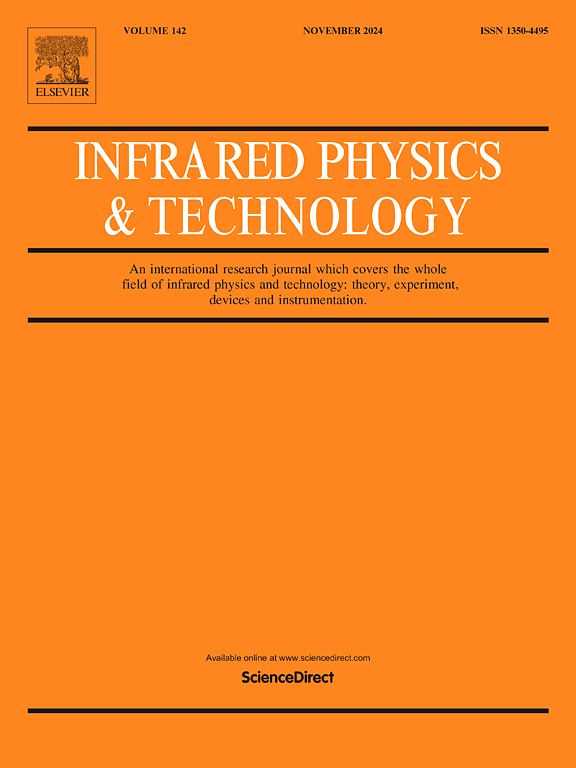Surface temperature and emissivity assessment in an enclosed cavity at high temperature using IR thermography
IF 3.1
3区 物理与天体物理
Q2 INSTRUMENTS & INSTRUMENTATION
引用次数: 0
Abstract
Assessing emissivity and temperature using IR thermography is challenging, particularly at high temperatures. Moreover, in an enclosed cavity, the multiple reflections of the signal before reaching the camera can lead to a geometry-dependent apparent increase in emissivity. In this work, we describe a novel approach for solving this problem in the context of measurements within a model aircraft engine combustion chamber. By using thermocouples and a multi-spectral camera, we experimentally validate our radiometric model for the cavity. We first show how to evaluate the amplification factor of a cavity using numerical tools, and we then use these results to apply corrections on the camera signals for in-band radiance (IBR) measurements. As a non-invasive and non-destructive technique, this approach can be used to monitor in real time the evolution of the temperature and emissivity over a large temperature range. As a specific example, we present and compare values measured by the camera and thermocouples inside the combustion chamber. Following the calibration step, we determine the emissivity and temperature distribution of the entire scene. The calculations are compared across 3 different wavebands to ensure their validity, with a difference lower than 2 %. Finally, we showcase the importance of assessing the in situ emissivity of a surface, which can change drastically with a large temperature variation and in a harsh environment. Using a calibration point given by a carefully placed thermocouple, the 2D temperature mapping of the whole scene is evaluated and compared in two different wavebands, leading to temperatures within across the wavebands when the combustion chamber is at 700℃.
利用红外热成像技术评估封闭腔体在高温下的表面温度和发射率
利用红外热像仪评估发射率和温度具有挑战性,特别是在高温下。此外,在一个封闭的腔中,信号在到达相机之前的多次反射会导致发射率的几何相关的明显增加。在这项工作中,我们描述了一种在模型飞机发动机燃烧室测量的背景下解决这一问题的新方法。通过使用热电偶和多光谱相机,我们实验验证了我们的辐射测量模型。我们首先展示了如何使用数值工具评估腔的放大因子,然后我们使用这些结果对相机信号进行带内辐射(IBR)测量的校正。作为一种非侵入性和非破坏性技术,该方法可用于在大温度范围内实时监测温度和发射率的演变。作为一个具体的例子,我们给出并比较了由燃烧室内的相机和热电偶测量的值。在标定步骤之后,我们确定了整个场景的发射率和温度分布。计算结果在3个不同的波段上进行了比较,以确保其有效性,差异小于2%。最后,我们展示了评估表面的原位发射率的重要性,它可以随着大的温度变化和恶劣的环境而急剧变化。利用精心放置的热电偶给出的校准点,在两个不同的波段对整个场景的二维温度映射进行评估和比较,得出当燃烧室温度为700℃时,整个波段的温度在ΔT=100C范围内。
本文章由计算机程序翻译,如有差异,请以英文原文为准。
求助全文
约1分钟内获得全文
求助全文
来源期刊
CiteScore
5.70
自引率
12.10%
发文量
400
审稿时长
67 days
期刊介绍:
The Journal covers the entire field of infrared physics and technology: theory, experiment, application, devices and instrumentation. Infrared'' is defined as covering the near, mid and far infrared (terahertz) regions from 0.75um (750nm) to 1mm (300GHz.) Submissions in the 300GHz to 100GHz region may be accepted at the editors discretion if their content is relevant to shorter wavelengths. Submissions must be primarily concerned with and directly relevant to this spectral region.
Its core topics can be summarized as the generation, propagation and detection, of infrared radiation; the associated optics, materials and devices; and its use in all fields of science, industry, engineering and medicine.
Infrared techniques occur in many different fields, notably spectroscopy and interferometry; material characterization and processing; atmospheric physics, astronomy and space research. Scientific aspects include lasers, quantum optics, quantum electronics, image processing and semiconductor physics. Some important applications are medical diagnostics and treatment, industrial inspection and environmental monitoring.

 求助内容:
求助内容: 应助结果提醒方式:
应助结果提醒方式:


